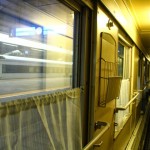Lending a helping hand in Luang Prabang Laos
The Home Stay
During our 14 days in Laos, we stayed for two nights at the villager’s house.
Apart from the flood of mosquitoes, the fact that it was very hot, and that I did not bring my insect repellant and Tiger Balm, it was a relatively comfortable stay.
Bathing facilities was fine. The house we stayed in had two toilets with concrete tanks filled with fresh cold water. The water was indeed fresh because I could see fishes swimming at the bottom.
It was nice to brush teeth with such fresh cold water and fishes (ok, I am weird).
If I had brought my Tiger Balm and insect repellant, I would have definitely welcomed a stay there for more days.
The house is inhabited by two old people, a husband and wife. The TV is always on. They receive programs from China, Thailand, and do have their local programmes. They are addicted to a Thai show at 9pm. It reminds me of a Taiwan drama serial my mum loves to watch.
The owners’ son is the 3rd important person in the village of Ban Xieng Lom. There are many villages in a city, and cities in a province.
We were staying in Ban Xieng Lom village, in the city of Luang Prabang, in the province of Luang Prabang. Let’s just say, the Luang Prabang province also has other cities.
Each village had a village head. He would settle all the internal affairs with government officials. He is elected based on popularity and will settle internal disputes. For almost every community event, he has to be present.
When we came to help out in the school located near the village, he was present at times. He helped in the construction of the recreation court, smoothing out the liquid concrete with a wooden plank.
The 3rd most important person was a farmer. His son is called Mat-Ni, and is an intelligent boy in the class I was helping to teach. He wears a gold chain around his neck.
At the storeroom of the house, we see many sacks of rice. There is a gentle fragrance when you walk into the storeroom. These sacks of rice are to be sold to the big supplier from the city, he said.
The money he gets is quite little I recall. I think it is about USD 1 for a kilogram of rice. He owns the land, he tells us. But he has to pay high land taxes to the government.
The next day, we try out planting rice on their land. I am bad at it because I can’t pin down the saplings in a straight line. But the villagers are nice about it. The farmer’s land is big. (in my opinion).
Life is better now. According to the Singaporean coordinator for our trip who speaks fluent Lao, Sir Liang, he tells us that life in Ban Xieng Lom has improved after the opening of the Elephant Village less than 1 kilometre away.
“Many villagers went there to work. With the tourism dollar, they have a better life now.”
The Elephant Village is indeed beautiful. I have never come so close up to elephants. Many locals are employed there. The waiters, the Mahouts (Elephant riders), the Boatmen.
Tourism has helped to change lives.
Education of children is affordable. Pre-school education cost 40,000 kip (USD0.50) a year. Primary education is 50,000 kip and Secondary Education is 60,000 kip, close to SGD1.
But still not all children can afford to go to school. There is disparity in the village, my friend observes. There are children who change their clothes everyday. Some don’t. They have dirt streaks on their faces, and their wounds are open.
I honestly have failed to notice these children. I guess maybe India has made me quite immune to the dirt, and wounds of children. Perhaps, it is so common, that it has become quite the norm and I don’t feel much. Perhaps I have seen worse, dirtier children, with flies around them, bony kids with fierce empty eyes, that maybe I have, by habit turn a blind side to poverty. Or maybe, some part of me has just accepted the harsh realities of life.
Maybe that is why I felt that this village was so wealthy. But the truth is, things could be better for them. For those who cannot own gold chains, own broken slippers, with a little smell around them.
Primary and secondary education may be affordable, but university education is highly priced. It cost 60,000 kip per semester (USD10), which is about 6 months (i think). It is alot, Sir Liang tells us. A government official earns USD50 per year. A farmer?
Will you get good jobs with a university degree?
Yes, the farmer nods his head vigorously. His son is now studying English at the Teacher’s Training College in Luang Prabang. He has gone to serve the army for a compulsory three months.
We see him the next day. He is 22 years old, wearing army camouflage trousers and a black singlet. He looks quite plump, unlike his father, who is thin and dark. He speaks to us in English.
Opportunities.
His brother is bright. Hope they will have a bright future.
I hand them a book with photographs of Singapore. While looking through the book, the farmer pauses at the pictures of our HDB flats. Sir Liang explains, that these are houses we live in.
He nods his head, looks closely at them, and flips the page.
This house he tells us, is made by their own hands. The house has many panels of wood, carefully nailed together. While walking up the staircase, I detect a slight movement by a slightly loose plank of wood.
When they are building houses, family members from all over gather together to help them. The coordinator of the trip, who runs some guesthouses in Luang Prabang tells us that sometimes these workers disappear without a word. When they come back, they tell him that they have gone back to their villages to help to build houses.
The houses are really quite beautiful. The rustic wood. When look at the passing houses along the streets of Luang Prabang, I feel a twitch in my heart.
* * *
Construction
Unlike Singapore, the cement used to build the recreation court for the Primary school was not pure cement. It was a mixture of fine soil, cement, water and stones. This could help them save the amount of cement used.
I never knew how tiring cementing a place could be. Lifting up these heavy buckets of stones, passing them through a human chain. Attempting to shovel stones and sand into the buckets give a whole new meaning to the word “back-breaking.”
But the most difficult of all was shovelling the ground to get rid of plants. The roots were stronger and whacking the ground to pluck out their roots was just so difficult.
I think I can understand how construction workers feel. When I see piles of sand and stones by the roadside. I am thankful for cement mixers in Singapore. And I am thankful that my Primary school basketball court was provided for, using 100% pure cement. I did not have to worry that the cement will chip off. Or stones popping out after wear and tear.
I am glad we did the court. Day by day, as I look at my cemented shoes, my tan brown skin and bruises and cuts that I got from the whole week of construction work, and when I see the cemented patches being filled, moving closer to me, a sense of accomplishment fills my heart.
We did it together. Now, the children can run, without the fear of slipping now in their muddy fields with sandflies. No more bites, no more splinters.
I am sure the villagers could have done it much faster and better than us. But I guess, it is because we came, and sweated along with them, and carried the load they had together, that made it all special, and made them want to finish this project.
That was the most meaningful of all things I did that trip.
(Drinking two bottles of Lao beer, and revealing my politically incorrect self to others was the next best thing.)
And I am happy to have gone to Laos, despite my many disillusionments.
Maybe, it’s just a tweak of perceptions, and openness, and adjustments.
Each new experience teaches us something. All we have to do, is to open the eyes, and our minds.
Appreciate what we have.
The uneven concrete floor, you can see some sand!
The kids, the concrete floor in the background
Playing on the concrete ground, the concrete is before touch-up, so it looks uneven.
The Farmer, whom we talked to, and stayed at his house
The Owner of the house we stayed in.
He likes to watch the world.
The wooden house we stayed in
Elephant Village, Tourist Spot
The Mahout










